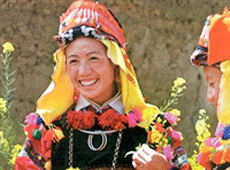Cloud covered Lung Cu Commune in Dong Van District of Ha Giang province, Vietnam’s northernmost point. The commune has a small hamlet, Lo Lo Chai, with only 81 households and slightly more than 300 people. Seen from the Lung Cu flag pole, the hamlet is so tiny, it fits within one’s peripheral view.
 Lo Lo Chai impresses visitors with its earthen-walled houses roofed with Yin-Yang tiles. Outside there is a stone fence surrounding each house. Most of the houses have two doors, on which there is a charm to expel demons and evil spirits. The ancestor altar is placed in the house and opposite the main door. The house is not divided into compartments, but when a bridegroom is welcome to the family, the host will use pieces of fabrics to make up a private compartment for the newly-wed couple.
Lo Lo Chai impresses visitors with its earthen-walled houses roofed with Yin-Yang tiles. Outside there is a stone fence surrounding each house. Most of the houses have two doors, on which there is a charm to expel demons and evil spirits. The ancestor altar is placed in the house and opposite the main door. The house is not divided into compartments, but when a bridegroom is welcome to the family, the host will use pieces of fabrics to make up a private compartment for the newly-wed couple.
When a visitor comes to the hamlet, all villagers are glad and excited, like they are on holiday. They present a set of bronze drums, which are considered s symbol of the Lo Lo people’s spiritual life. After the bronze drum presentation, the hamlet’s artistic group performs songs and dances. Lo Lo dance is a communal activity that reflects the group’s working and spiritual life.
The attire of Lo Lo women are widely known as the group’s unique cultural identity. Lo Lo women weave fabrics with which they make skirts. Usually the consumers are not for sale. If a visitor is willing to buy, the local women will meet their demand. Some visitors have placed orders to have a Lo Lo ethnic costume at VND3-4 million. The fabrics are often hot colours that go well with silver or aluminum jewelery, hence highlighting the wearer’s beauty and charm. Lo Lo men, when searching for their future wives, often evaluate carefully their girlfriends through their ability to make clothing.
Nowadays, many Lo Lo women are wearing modern outfits, but their traditional costumes are still a worthy pride of their ethnics group.